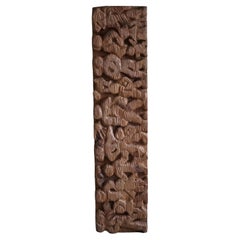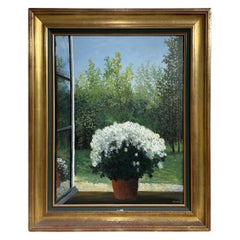Hand-Carved Decorative Art
1950s English Vintage Hand-Carved Decorative Art
Brass
2010s American Modern Hand-Carved Decorative Art
Oak
2010s American Modern Hand-Carved Decorative Art
Glass, Walnut
Mid-20th Century French Organic Modern Hand-Carved Decorative Art
Pine, Wood
1950s Mid-Century Modern Vintage Hand-Carved Decorative Art
Plaster
Mid-20th Century French Mid-Century Modern Hand-Carved Decorative Art
Canvas, Giltwood
21st Century and Contemporary Italian Louis XVI Hand-Carved Decorative Art
Wood, Paint
20th Century Spanish Renaissance Revival Hand-Carved Decorative Art
Gold Leaf
Late 18th Century Swedish Gustavian Antique Hand-Carved Decorative Art
Mirror, Pine, Giltwood
17th Century Italian Renaissance Antique Hand-Carved Decorative Art
Gesso, Canvas, Giltwood
Early 20th Century German Black Forest Hand-Carved Decorative Art
Walnut
1950s Mid-Century Modern Vintage Hand-Carved Decorative Art
Plaster
Early 1900s Italian Baroque Antique Hand-Carved Decorative Art
Canvas, Giltwood
Late 19th Century Italian Other Antique Hand-Carved Decorative Art
Gesso, Paint, Giltwood, Canvas
17th Century French Baroque Antique Hand-Carved Decorative Art
Canvas, Giltwood
18th Century Swedish Gustavian Antique Hand-Carved Decorative Art
Glass, Giltwood, Mirror
Late 20th Century Mexican Arts and Crafts Hand-Carved Decorative Art
Leather, Wood, Paper
Late 19th Century Swedish Belle Époque Antique Hand-Carved Decorative Art
Canvas, Giltwood
Early 1900s Italian Baroque Antique Hand-Carved Decorative Art
Canvas, Giltwood
19th Century French Gothic Revival Antique Hand-Carved Decorative Art
Metal, Brass
Mid-19th Century Italian Renaissance Antique Hand-Carved Decorative Art
Gold Leaf
Late 18th Century French Empire Antique Hand-Carved Decorative Art
Giltwood
21st Century and Contemporary Italian Hand-Carved Decorative Art
Wood, Paint
1950s German Arts and Crafts Vintage Hand-Carved Decorative Art
Metal
Early 20th Century Unknown Hand-Carved Decorative Art
Walnut
Mid-20th Century American Hand-Carved Decorative Art
Wood
21st Century and Contemporary Portuguese Modern Hand-Carved Decorative Art
Art Glass, Fiberglass, Paint
Mid-17th Century English Antique Hand-Carved Decorative Art
Steel
19th Century English Victorian Antique Hand-Carved Decorative Art
Oak
Mid-20th Century French Hand-Carved Decorative Art
Ceramic
Mid-19th Century Chinese Qing Antique Hand-Carved Decorative Art
Metal
Early 20th Century Dutch Art Deco Hand-Carved Decorative Art
Metal, Brass, Zinc, Chrome
Mid-20th Century Italian Mid-Century Modern Hand-Carved Decorative Art
Metal, Brass
Mid-18th Century Italian Baroque Antique Hand-Carved Decorative Art
Fruitwood
Late 20th Century Italian Baroque Revival Hand-Carved Decorative Art
Fruitwood
Late 18th Century Italian Neoclassical Antique Hand-Carved Decorative Art
Giltwood
2010s Finnish Modern Hand-Carved Decorative Art
Wood
Mid-19th Century Italian Early Victorian Antique Hand-Carved Decorative Art
Wood
2010s Finnish Modern Hand-Carved Decorative Art
Wood
1970s Italian Mid-Century Modern Vintage Hand-Carved Decorative Art
Pine
Mid-18th Century Italian Baroque Antique Hand-Carved Decorative Art
Fruitwood
1830s French Napoleon III Antique Hand-Carved Decorative Art
Wood, Giltwood, Glass
Early 20th Century Argentine Hand-Carved Decorative Art
Canvas, Paint
Mid-18th Century Spanish Antique Hand-Carved Decorative Art
Wood
18th Century Spanish Antique Hand-Carved Decorative Art
Wood
Mid-18th Century French Antique Hand-Carved Decorative Art
Oak
2010s French Hand-Carved Decorative Art
Sterling Silver
20th Century Chinese Hand-Carved Decorative Art
Wood
19th Century African Antique Hand-Carved Decorative Art
Wood, Paint
Early 20th Century American Hand-Carved Decorative Art
Bone, Wood
Late 19th Century French Antique Hand-Carved Decorative Art
Ceramic, Majolica
Early 20th Century European Neoclassical Hand-Carved Decorative Art
Hardwood
1930s Argentine Art Deco Vintage Hand-Carved Decorative Art
Wood
19th Century British Folk Art Antique Hand-Carved Decorative Art
Wood
1970s Italian Mid-Century Modern Vintage Hand-Carved Decorative Art
Pine
Late 18th Century American Federal Antique Hand-Carved Decorative Art
Wood
Late 19th Century French Baroque Antique Hand-Carved Decorative Art
Copper
Early 20th Century European Victorian Hand-Carved Decorative Art
Brass, Enamel
Read More
At Colonial Williamsburg, Everything Old Is New Again
With the help of a new director, the Virginia institution's folk art and decorative arts museums are undergoing extensive upgrades.
New York’s Hirschl & Adler Showcases the American Workmanship and Design Panache of Neoclassical Treasures
The gallery's latest exhibition proves that museum-quality pieces entice and inspire, whether in traditional or more modern interiors.



